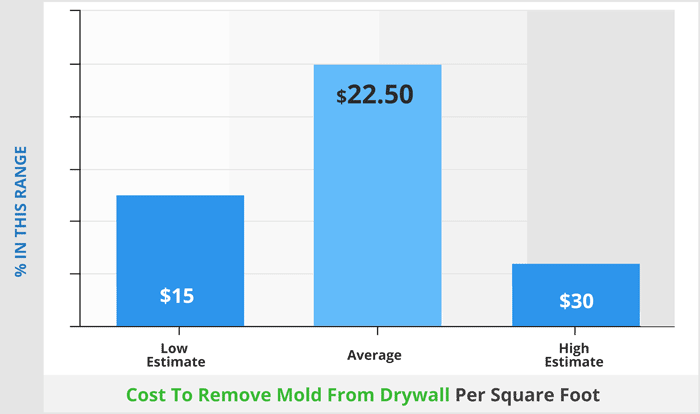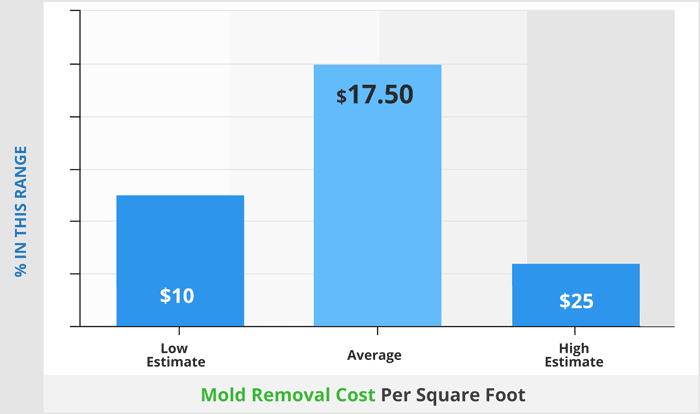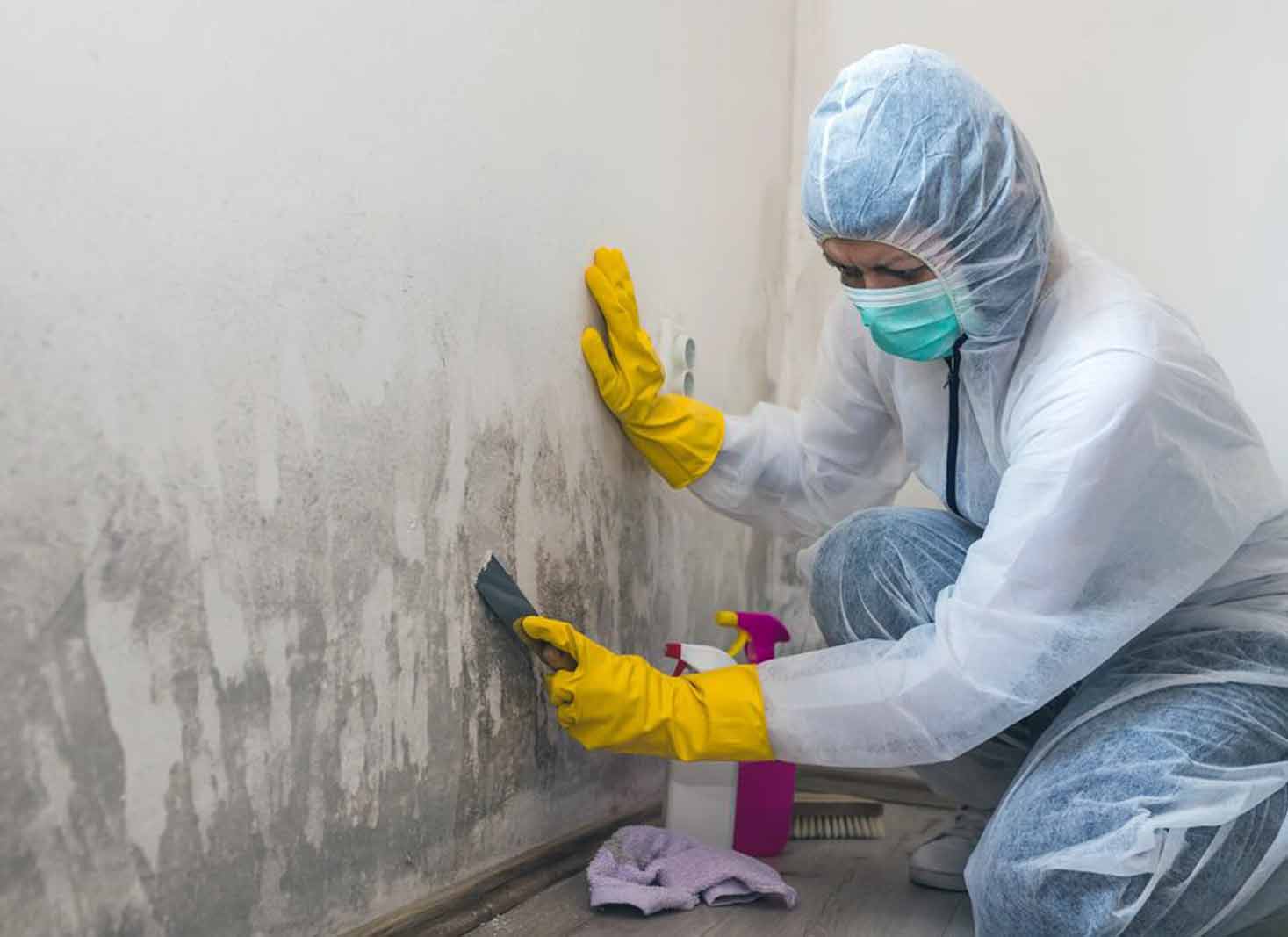Mold frequently becomes an issue within buildings, particularly in places where humidity is elevated. Its swift proliferation and dissemination can harm the property and might pose potential health hazards. Knowing how much mold eradication costs is crucial in order to address the problem promptly before it escalates.
Removing mold from drywall costs $15 to $30 per square foot. Depending on the extent of the mold damage, you may need to consider replacing drywall in some sections.
The price can vary depending on multiple factors, including whether your drywall needs a repair or a total replacement. Other price considerations may include other materials, such as any leaking pipes that need to be replaced.

What we cover
ToggleMold remediation cost per square foot
On average, mold remediation companies charge somewhere between $10 and $25 per square foot. For example, if the mold growth is across a 100-square-foot room, you can expect to spend between $1,500 and $ 3,150.
Normally, mold remediation companies will charge by square feet for small mold infestations. However, if the mold infestation covers a large space, they may need to charge you for the entire space.
For reference, below are the estimates for mold remediation per area size:

| Description | Average cost range (labor included) |
|---|---|
| 50 square feet area | $500 to $1,250 |
| 100 square feet area | $1,000 to $2,500 |
| 150 square feet area | $1,500 to $3,750 |
| 200 square feet area | $2,000 to $5,000 |
| 300 square feet area | $3,000 to $7,500 |
Should I replace moldy drywall?
This will depend on the extent of the damage. Regular drywall does not like moisture, so if it has been wet for a longer period of time it may have warped or be beyond repair.
It is cheaper to kill mold than replace drywall, once the cause of the mold has been remedied, it might be worth replacing affected sections and starting fresh.
How to kill mold behind drywall
This is tricky as you need to access the mold directly to kill it.
I suggest first to drill a small hold into drywall where you suspect mold may be. Use a mold detector to test the air behind the drywall. If it comes back positive, you can spray a bleach: water mix (1:3) through the hole to kill the mold then fill it in.
You need to bear in mind that there are vertical battens and horizontal studs that make up the internal structure of the wall and separate it into sections. You will need to drill a hole in each of these sections and apply the mold-killing mix.
Factors that affect the cost of mold remediation
There are various factors and considerations that can influence the total cost of your mold remediation. While mold remediation can fairly get expensive, below are some of the factors that you can expect to influence the total cost of your project.
Type of mold
Mold problems and the ways to solve them can vary depending on the type of mold that you are dealing with.
Non-toxic molds will cost you less compared to toxic forms of mold. This is because mold removal companies will need more safety equipment and chemicals when dealing with harmful molds.
Size of area
When dealing with mold removal services, the size of the mold growth plays a big role in the total cost. The bigger the area, the bigger you’ll expect to pay.
Normally, mold does not creep through an entire room. With that, mold removal companies typically charge for each square foot of the affected area, which can be convenient when the mold is only minimal.
However, for larger areas that require drywall, the price might get high.
Location of the mold growth
Aside from the size and type of mold, the location of the mold growth also affects most of your mold removal.
Since mold can grow anywhere, it can also grow in hard-to-reach places, and this can reflect your total cost.
If you need to remove mold from your entire home, you should expect to spend anywhere between $1,200 and $8,300. Although this cost range may vary for areas that are difficult to reach and the surface that they grew on.
Inspection and testing cost
Before having your mold problem removed and solved, you will need to have your home inspected and tested by an expert. The expert will do his job to see the degree and the area of the mold and will take a sample from it.
You can expect to spend between $450 and $800 for a general mold inspection, depending on the area of your home. Mold testing can cost as little as $50 to $700.
If you have gotten sick because of the mold, your insurance company may need you to get tested to prove that your illness is caused by mold growth in your home.
Repair costs
When you find mold in your home, you should expect to have repair or improvement costs. This is to prevent future mold growth and to make up for the damage incurred due to the mold.
While improvement and repair costs are additional expenses, they will still save you money in the long run since it makes up for the restoration of the value of your home, making it a more liveable place. This is not covered by the mold remediation company.
Mold thrives in unhealthy and moist environments. If you turn your home into a conducive and more liveable place, you remove the risk of mold growth.
Other factors
Aside from the factors discussed above, the cost of dealing with mold also depends on the area that you live in, and the average costs of the mold removal companies there.
You should also take note of the healthcare costs that you and your family incurred while dealing with the mold. Mold can be very hazardous, especially for those with allergies and underlying illnesses.
Mold remediation: DIY vs hiring a professional
Aside from considering the total cost of your mold remediation, you should also consider whether hiring a professional or doing it yourself is the best for you. The choice can be simple.
Since mold remediation can get technical, it can be challenging for you to deal with it alone even just by identifying the source. Preventing the mold growth can also be tricky with just household items.
To make sure that your mold remediation is top-notch and effective, you can rely on mold remediation experts to do their jobs. Here are a few reasons why you should hire an expert:
- Experts have the knowledge and experience to safely get rid of all types of mold.
- They know how to control and reduce the potential spread of mold.
- Hiring experts is time-effective and cost-effective in the long run.
- Experts will help prevent future mold problems.
Who pays for mold remediation - the tenant or the landlord?

Either the tenant or the landlord who finds evidence of mold growth in a rental property should promptly seek a mold expert or inspector who can deal with the mold.
When it comes to determining whose responsibility it is to cover the mold remediation, both parties should refer to the lease agreement and cooperate with each other to fix the mold problem.
Mold problems can be quite a hassle since they can cause health, home, and eventually, financial problems. Dealing with this requires joint cooperation from the tenant and the landlord for rental properties.
When is mold remediation required?
At times, mold is not always dangerous, but it can still negatively impact someone’s health when exposed. With this, mold remediation becomes necessary after finding traces of mold in your home.
Traces of water leaks or pipe damages
Mold can build up because of moisture. If your property or home has recently been damaged by flooding or water leakages that came unchecked, then, you will most likely have to deal with mold growth.
If this happens, you have to call your local plumber to fix it right away. One of the key things to remember is that preventing water leaks will also prevent the growth of mold.
Presence of foul odor
Eventually, mold will start to develop a foul smell that will be noticeable. If you are keen to follow the smell, you might find the source of the powerful smell.
Various molds give off different odors. However, mold will generally smell damp and musty. Once you smell a hint of these odors, you might have to call a mold inspector to locate the source right away.
Evidence of physical damage
If you see signs of any structural or physical damage to some parts of your property including discoloration, dampness, and any signs that were not there before, you should immediately seek the attention of a mold remediation company.
If the mold is strong enough to physically affect your property, the more you should urgently seek professional help. Have a professional remove the mold to avoid further mold damage and mold growth.
Health effects
There are some species of black mold that are toxic and could affect your health such as causing allergic reactions, or worse, triggering respiratory infections and diseases.
If you see any signs of mold, it might be best to have a mold remediation company remove it to avoid causing health complications to you and your family. This is highly important, especially for those with existing conditions and allergies.













